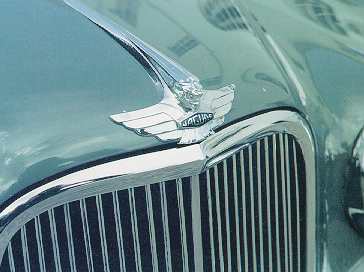| Notes |
After the war Jaguar, like other manufacturers wanted to
produce and sell exciting new models. Development work on a new flagship sedan model to
replace the prewar design had been started even before the end of the second world war.
However, as mentioned in the MK V and XK120 pages, in the austerity years after the war,
development took longer than Jaguar could afford to wait if they were not to loose
potential sales, so in the end, major components that were ready were incorporated into
other models, both to give these components a trial run, and also to introduce face lifted
cars to a fickle public that might otherwise have bought other makes. Thus it was that the
new chassis developed for the MK VII first appeared in the MK V model, and the then
all-new XK engine was first fitted to the XK120, which was initially intended as a
"concept car" of the day. The MK V, while it looked very similar to the pre-war
design was apparently enough to hold potential buyers attention until the introduction of
the MK VII with its promise of both new styling and the marvellous new XK engine. The
pieces finally all came together with the introduction of the MK VII in 1950. Logically
this model should have been the MK VI but legend has it that, as Bentley had already used
that name, Sir William thought he would upstage them with a "newer" Mark. The
car featured styling which was evolutionary from the previous MK V model, but with
definite hints of the beautiful lines of the XK120. It was also a much bigger car than the
MK V - 9 inches longer and 4 inches wider. Taking cues from the XK120 it had a somewhat
unadorned appearance with even the the radiator grille lacking a prominent chrome
surround.

It was available initially only as a 4 door sedan with 4 speed manual
transmission. Apparently a drop head coupe model was considered, but never produced. From
the outset it was very popular and sold well, especially in the USA where it earned
valuable foreign currency for England. It was reputably the American buyers who let
Jaguar know, that while they loved the car, they would appreciate an automatic gear box,
and Jaguar responded by making a Borg Warner automatic option available in 1953.
The car was updated to the MK VIIM in September 1954 and numerous small changes were
made. External identifiers include the changing of the old fashioned trafficator semaphore
signals for fender mounted flashing turn signals, a more "wrap around" rear
bumper, free standing fog lamps instead of being fitted flush to the front of the car, and
more modern headlamps. Inside the car the major change was fitment of a full width bench
front seat on automatic models. Engine power was up 30bhp with the use of the engine from
the XK140 of the same year, which featured high lift
camshafts.
Twin fuel tanks were fitted in the rear fenders, starting a trend which was followed by
the MKVIII, the MK IX, the MK X and 420G, and the XJ6/12 models.
A point of interest is that all the years from the MK V to the MK X Jaguar always
introduced the latest model in parallel with the one that replaced it. Thus the MK V was
sold alongside the MK VII in the showroom, as was the MK VII and the MKVIII, the MKVIII
and the MKIX, and the MKIX and the MK X. Typically they had a parallel sales period of up
to a year before production of the older model ceased and/or supplies ran out. |